-
开放科学(资源服务)标志码(OSID):

-
水溶性聚合物广泛应用在稳定剂、分散剂等领域[1-2]. 美国食品药品监督管理局(FDA)认可的一类水溶性聚合物为聚乙二醇(PEG),其具有相容性和水溶性好,且价廉等优良性能. 聚乙二醇及其衍生物在生物技术和药物传输等方面展现了较好的前景. 例如,聚乙二醇可运用于降低抗原性与免疫原性[3]、沉淀蛋白[4]、防止被酶和细胞降解等领域[5].
聚乙二醇作为一种水溶性聚合物,常被用作共轭段与其他疏水聚合物共聚,其高的水合能力有利于调节材料的亲水性. 聚乙二醇基共聚物也是一种温度响应性聚合物,例如当其与聚(乙烯醚)、聚苯乙烯、聚(降冰片)和聚酯或聚(丙烯酸酯)形成共聚物时,在某些领域可取代传统的温度响应性的聚(n-异丙基丙烯酰胺). 聚乙二醇基共聚物[6]在生理介质和水溶液中显示出低的临界转变温度,且高分子链具有可逆形态转变,通常应用于生物医学领域. 例如,紫杉醇负载于单甲氧基聚乙二醇(mPEG)-b-聚丙交酯胶束中,并在不损失细胞毒性的情况下可从胶束中释放[7]. 聚谷氨酸-单甲氧基聚乙二醇纳米胶束可被应用于血液循环中[8]. LIN D S等[9]合成了甲氧基聚乙二醇单甲醚-聚己内酯-聚甲基丙烯酸二甲氨基乙酯三嵌段共聚物并研究了其自组装行为并用于载药和释药领域. 除上述mPEG共聚物外,其他共聚物如接枝壳寡糖共聚物(COS-g-PCL-b-mPEG) [10],mPEG-壳聚糖双嵌段共聚物[11]等也可用于药物载体领域.
松香是一种热塑性固体树脂,存在于天然松树的油脂中[12]. 松香不溶于水,但通过引入亲水基团,松香衍生聚合物可以变成水溶性. 如以松香酰亚胺、马来酸酐加成物为基础的非离子表面活性剂可作为石油原油污泥分散剂[13]. 两亲性聚乙二醇-聚脱氢松香甲基丙烯酸乙酯嵌段共聚物在阻碍肿瘤生长中表现出优越的性能[14]. 两亲性松香基共聚物在亲水和疏水作用力下可发生多种高分子链形态转变. 固体酸催化法、酰氯酯化法和质子酸催化法是松香酯化共聚的常见方法[15-16]. 我们实验室制备了两亲性脱氢松香酸-丁二酸聚酯并研究了其胶束化和在水中的分子链的形态转变过程[17].
本研究合成了聚乙二醇单甲醚-马来松香酸聚酯,得到了其临界胶束浓度,并探究了聚乙二醇单甲醚-马来松香酸聚酯在变温水溶液中的形态转变及形成胶束的行为,结果表明其具有温度响应性,可应用于温敏性载体及绿色表面活性剂.
HTML
-
甲氧基聚乙二醇购自阿拉丁(AR,M为1000);4-二甲氨基吡啶购于上海雅本(AR,DMAP);马来松香为广西林产化学与工程重点实验室自制(纯度可达到99%);1-乙基-(3-二甲基氨基丙基)碳二亚胺盐酸盐购于三盛生物科技(AR,EDC);MEM培养基来源于HYCLONE;T25培养瓶、96和24孔培养板均来源于CORNING;胰酶来源于生工生物;Cell Counting Kit-8来源于碧云天(C0042,CCK-8);FBS来源于GIBCO;活细胞/死细胞染色试剂盒来源于贝博(BB-4126);其他溶剂皆为分析纯.
-
以干燥的250 mL单口烧瓶为反应容器,在氮气存在下加入3.05 g DMAP,2.23 g马来松香,12 g MPEG,加入二氯甲烷与搅拌子,使体系降温到0 ℃,保持温度为0 ℃的条件下加入4.6 g EDC,氮气氛围下反应30 min后,移走冰块,室温下继续反应2 d,透析10 d(透析袋分子量为2 000,溶剂为水和乙醇)后在50 ℃温度下旋转蒸干,产物为聚乙二醇单甲醚-马来松香酸聚酯.
-
使用美国Nicolet Magna公司IR-550(Ⅱ)型傅里叶红外光谱仪表征其特征基团与化学结构;1H核磁光谱用德国Bruker公司AV600/400型核磁共振光谱仪测定;用日本岛津UV1800型紫外可见分光光度计测试聚乙二醇单甲醚-马来松香酸聚酯水溶液的紫外吸收光谱;用Waters公司Waters 1525型凝胶渗透色谱表征聚乙二醇单甲醚-马来松香酸聚酯分子量及其分布;利用德国NETZSCH公司STA449F3 Jupiter热重分析仪对材料的热性能进行分析,测试温度区间为25~700 ℃,升温速率控制在10 ℃/min.
-
聚乙二醇单甲醚-马来松香酸聚酯的细胞毒性由CCK8实验表征. 当培养瓶内L929密度为100%时,消化并得到细胞悬液,计数,在96孔培养板内(4×10 4个细胞/孔)连续培养24 h(5% CO2、温度为37 ℃). 分别加入浓度为50,300,500 μmol/L的聚乙二醇单甲醚-马来松香酸聚酯,控制组加入灭菌水. 继续培养24 h后加入CCK8(10 μL),1 h后室温下轻轻震荡10 min,然后以酶标仪(Perkinelmer,EnSpire)测定OD450值,各个样品平行测定5次.
-
当培养瓶内L929相对密度为100%时,消化并得到细胞悬液,计数,96孔培养板内(1.5×10 5个细胞/孔)培养24 h(5% CO2、温度为37 ℃). 加入浓度为50,300,500 μmol/L的聚乙二醇单甲醚-马来松香酸聚酯,控制组加入灭菌水,在37 ℃、5% CO2条件下培养24 h. 以1 500 r/min的转速离心5 min,轻轻除掉上清,冲洗后进行染色(calcein AM稀释浓度1 000倍,PI染料稀释浓度20 000倍),采用分开染色方案也即calcein AM染色25 min,PI染色5 min. 用荧光显微镜(OLYMPUS,U-RFL-T)得到活细胞与死细胞图像,分别为黄绿色与红色.
-
利用BZY-2表面张力仪测定临界胶束浓度. 弹性光散射光谱与强度是通过用美国PE公司LS-55型的荧光分光光度计来测定的. 激发和发射狭缝均设置为2.5 nm[18]. 可以进行升温与降温控制,升温与降温速率是1 ℃/min,每一温度测定3次.
1.1. 实验材料
1.2. 合成聚乙二醇单甲醚-马来松香酸聚酯
1.3. 聚乙二醇单甲醚-马来松香酸聚酯的表征
1.4. 聚乙二醇单甲醚-马来松香酸聚酯细胞毒性表征
1.4.1. 细胞活性的测定
1.4.2. Live/Dead细胞荧光染色实验
1.5. 聚乙二醇单甲醚-马来松香酸聚酯温度响应性胶束形成及形态转变研究
-
图 1为聚乙二醇单甲醚-马来松香酸聚酯红外光谱,亚甲基的伸缩振动位于2 870 cm-1处,甲基亚甲基的弯曲振动位于1 450 cm-1,1 349 cm-1处[19];酯基中C = O的伸缩振动位于1 724 cm-1处;羧基和封端羟基的O—H伸缩振动位于3 518 cm-1宽峰处,羧基中O—H的弯曲振动位于949 cm-1,C—O—C的伸缩振动峰位于1 103 cm-1[20],且该峰较强,因此认为成功得到了聚乙二醇单甲醚-马来松香酸聚酯.
图 2为聚乙二醇单甲醚-马来松香酸聚酯的1H核磁共振图,谱峰的归属信息见表 1. 通过1H核磁共振图谱可知马来松香酸C = C上与甲氧基上H个数比1∶5,也即2个聚乙二醇单甲醚通过酯化方法接到一个马来松香酸上. 聚乙二醇单甲醚-马来松香酸聚酯结构如图 3所示.
根据聚乙二醇单甲醚-马来松香酸聚酯凝胶渗透色谱图(图 4)可知,馏分馏出时间为30 min,聚乙二醇单甲醚-马来松香酸聚酯的数均分子量是2 500,多分散系数为1.32.
-
如图 5所示,聚乙二醇单甲醚-马来松香酸聚酯最大吸收峰位于195 nm,280 nm左右有一个吸收峰,而在更高波长处吸收值为0.
-
由TG和DTG曲线(图 6)可知,聚乙二醇单甲醚-马来松香酸聚酯在大概380 ℃开始分解,400 ℃左右分解最为剧烈,420 ℃时完全分解. 分解温度范围较窄,这一结果也表明聚乙二醇单甲醚-马来松香酸聚酯分子量分布较窄.
-
L929细胞存活率见图 7. 当聚乙二醇单甲醚-马来松香酸聚酯浓度为50 μmol/L时,L929细胞存活率为102%;当浓度为300 μmol/L时,L929细胞存活率为84%;而当浓度为500 μmol/L时,L929细胞存活率为72%;显示聚乙二醇单甲醚-马来松香酸聚酯的低毒性. 活/死细胞荧光显微镜观察(图 8)中不同浓度的聚乙二醇单甲醚-马来松香酸聚酯培养的活/死细胞染色多数为黄绿色荧光,少数为代表死细胞的红色荧光,表明聚乙二醇单甲醚-马来松香酸聚酯具有良好的生物相容性.
-
以聚乙二醇单甲醚-马来松香酸聚酯水溶液的弹性光散射强度对应质量浓度曲线可得到聚乙二醇单甲醚-马来松香酸聚酯临界胶束质量浓度.
由理论上可知,当散射峰出现在吸收强度减小的波长处时所得的散射光谱为弹性光散射[21]. 由图 9可知,聚乙二醇单甲醚-马来松香酸聚酯最大散射强度位于390至410 nm区间,而其紫外在低于280 nm时存在吸收,280 nm处有1个小的吸收峰,由此可判断聚乙二醇单甲醚-马来松香酸聚酯属于弹性光散射. 聚乙二醇单甲醚-马来松香酸聚酯水溶液的弹性光散射强度与质量浓度大小有关,各质量浓度下的散射强度见图 10(溶液质量浓度为2.5,2.2,1.8,1.5,1.0和0.50 g/L). 当质量浓度较低时,散射强度几乎不变,散射强度在高于1.5 g/L时增大,此时分子链发生了聚集形成了胶束,因此1.5 g/L为聚乙二醇单甲醚-马来松香酸聚酯水溶液的临界胶束质量浓度[22].
-
研究了两种不同质量浓度(c=0.13 g/L,1 g/L)的聚乙二醇单甲醚-马来松香酸聚酯水溶液弹性光散射强度-温度曲线. 两种样品的散射强度变化趋势不尽相同[23]. 散射强度-温度曲线能反映聚集体的尺寸及高分子链的形态转变. 而聚集体与高分子链的形态转变主要源于各种相互作用力的大小与变化,如分子间的疏水作用力、各组分之间的范德华力以及氢键等使得聚合物在各个不同的温度呈现不同的形态与聚集态.
图 11为聚乙二醇单甲醚-马来松香酸聚酯溶液变温过程中(c=0.13 g/L)光散射强度变化情况. 由25 ℃开始升温,在此过程中光散射强度增大,45 ℃时达到最大值. 由于光散射强度表明了聚集体尺寸的大小,25~45 ℃区间分子链形态发生变化,产生聚集体组成胶束. 马来松香的疏水段发生集聚,亲水链段包裹在马来松香疏水段周围形成胶束. 高于45 ℃时,散射强度又开始下降,到达90 ℃后,散射强度不再改变,即45~90 ℃聚乙二醇单甲醚-马来松香酸聚酯聚集体分子链形态由较伸展变为紧缩,主要是由于亲水链段与水之间的氢键被破坏,亲水段的紧缩使胶束尺寸变小. 高于90 ℃时胶束的大小不变,此时疏水作用、各式范德华力与氢键作用力达到平衡状态. 降温过程中聚乙二醇单甲醚-马来松香酸聚酯酯形态发生变化、胶束尺寸变化趋势与升温过程相反. 升温过程中的弹性散射强度较小,可能是由于小部分升温过程中形成的聚集体胶束沉积在溶液底部,难以再次发生形态与聚集胶束形态的转变导致的.
同时,当质量浓度为1 g/L时也进行了相应的变温测试,结果见图 12. 升温过程中分子链形态转变过程与质量浓度为0.13 g/L相似,该浓度下的转折温度位移到55 ℃左右,降温过程散射强度变化趋势与升温过程相似,形态转变转折温度为63 ℃. 表明聚乙二醇单甲醚-马来松香酸聚酯水溶液在变温条件下发生的分子链形态与胶束尺寸的转变过程是可逆的,但存在一定的滞后. 这可能是由于在较高浓度时分子团聚后,胶束间的互相作用力更强,要打破这种平衡的团聚状态需要更大能量,所以需要在更高温度才能进行分子链形态的转变及胶束的解离. 由此可知,聚乙二醇单甲醚-马来松香酸聚酯在各质量浓度下均表现出优良的温度响应性. 聚乙二醇单甲醚-马来松香酸聚酯分子链形态与聚集体胶束转变见图 13.
2.1. 聚乙二醇单甲醚-马来松香酸聚酯化学结构与分子
2.2. 聚乙二醇单甲醚-马来松香酸聚酯的紫外-可见吸收光谱
2.3. 聚乙二醇单甲醚-马来松香酸聚酯热分解温度
2.4. 生物相容性
2.5. 聚乙二醇单甲醚-马来松香酸聚酯临界胶束质量浓度的测定
2.6. 聚乙二醇单甲醚-马来松香酸聚酯在变温条件下形态转变
-
本研究通过酯化的方法制备了具有温度响应性的聚乙二醇单甲醚-马来松香酸聚酯,对其进行了结构表征、热性能研究及细胞毒性研究. 考察了聚乙二醇单甲醚-马来松香酸聚酯各质量浓度溶液在变温条件下的高分子链及聚集胶束形态转变. 结果证明,聚乙二醇单甲醚-马来松香酸聚酯表现出温度响应性,形态转变具有温度可逆性. 聚乙二醇单甲醚-马来松香酸聚酯制备简便,具有良好的生物相容性与温度响应性,可应用于绿色表面活性剂及温度响应性载体.

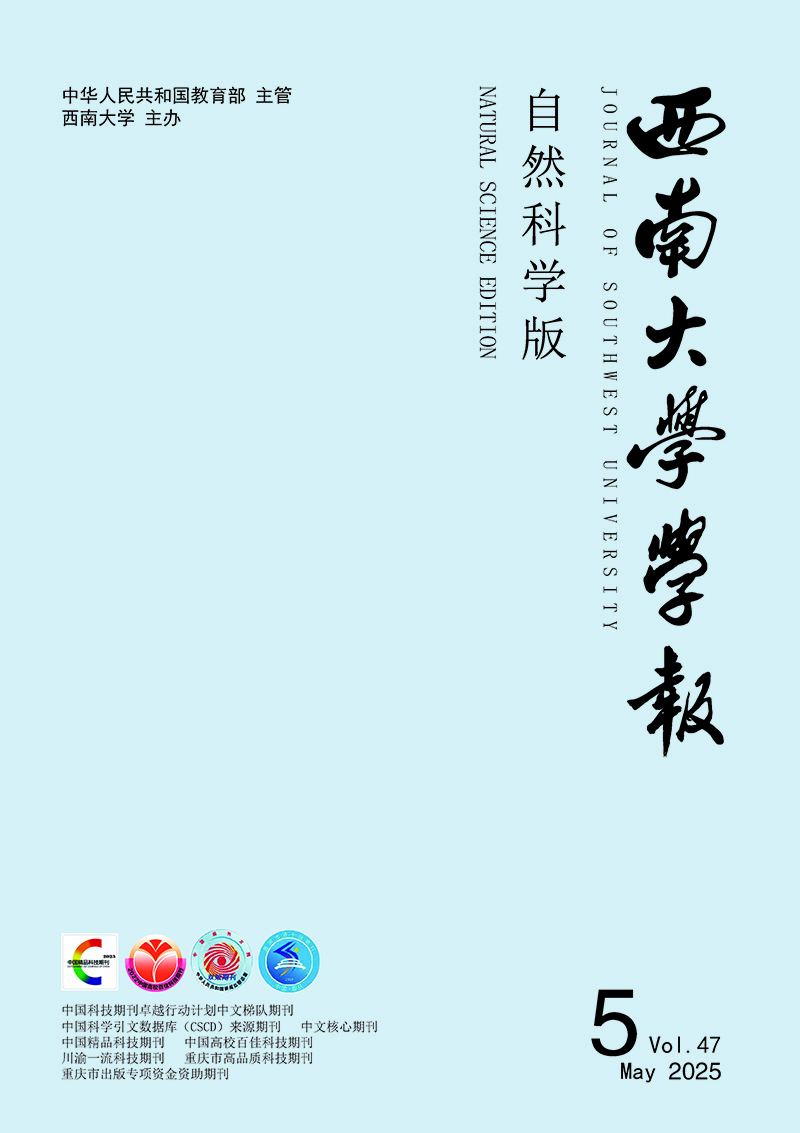


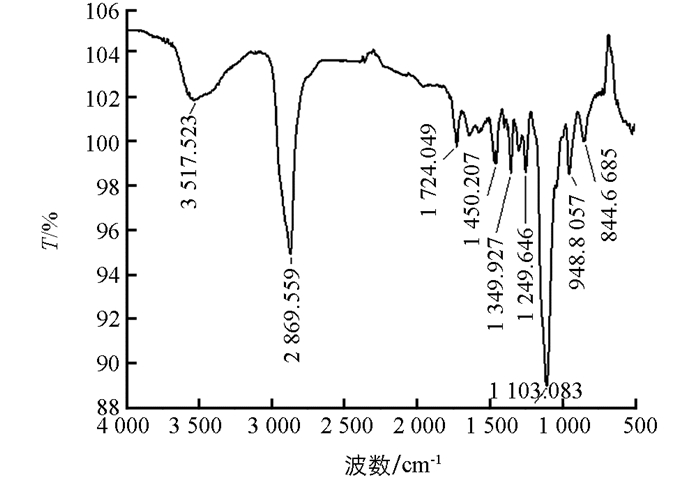


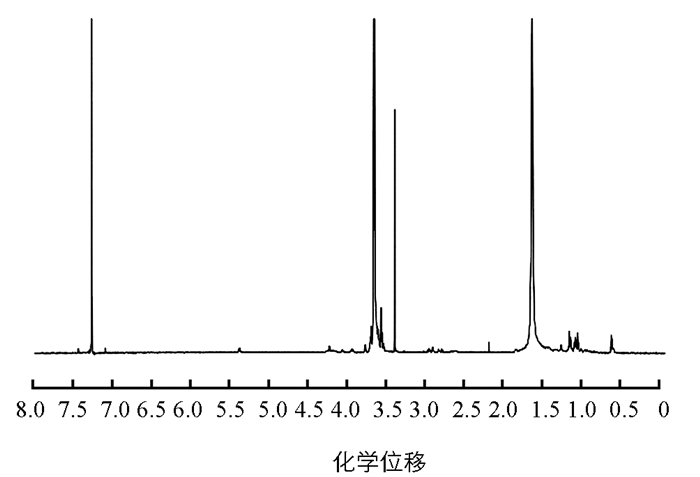

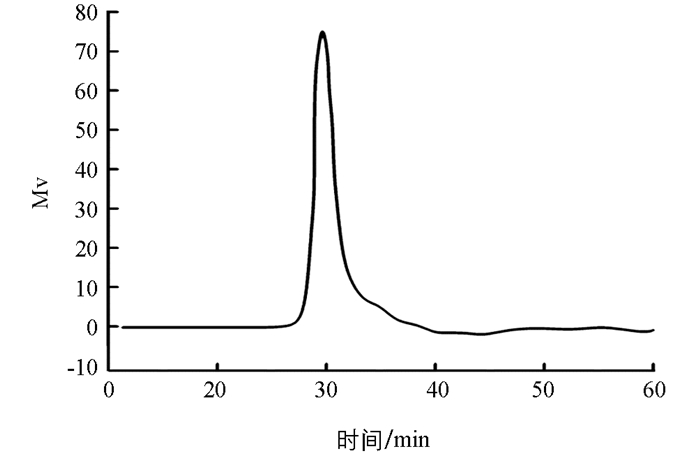
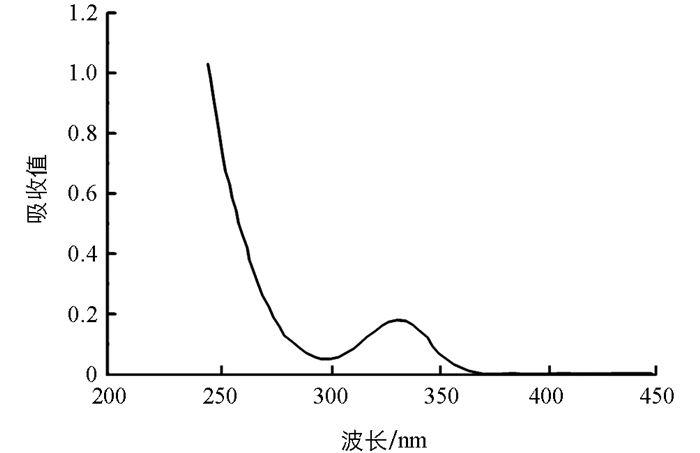
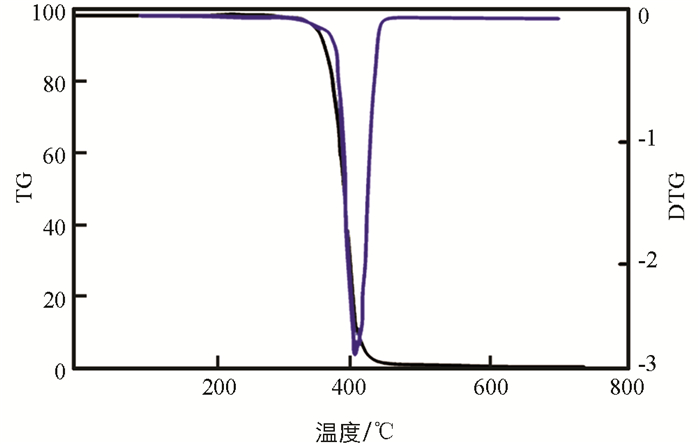
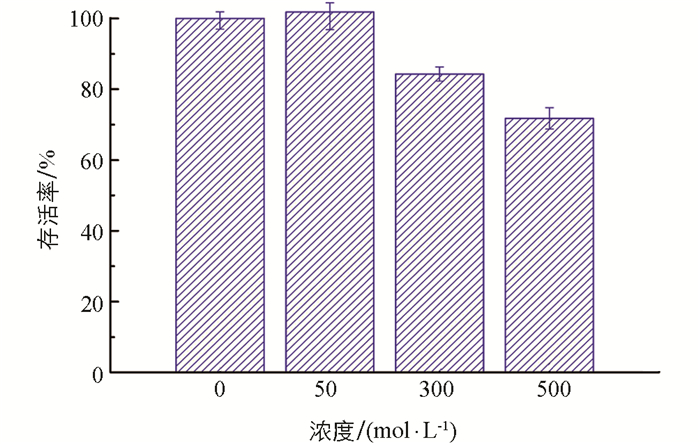
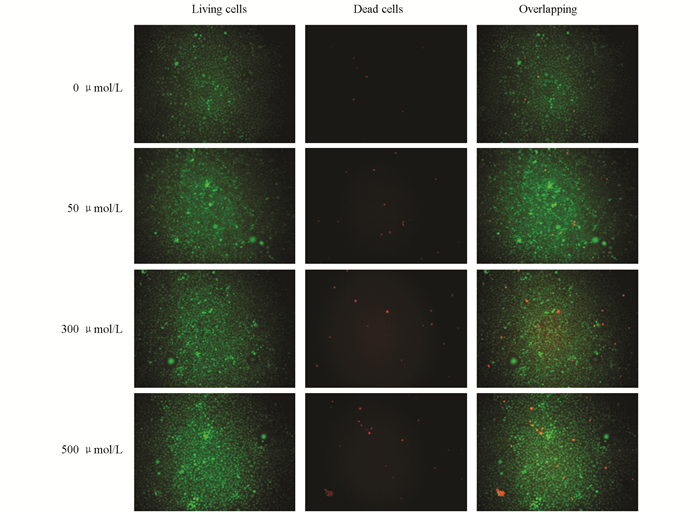
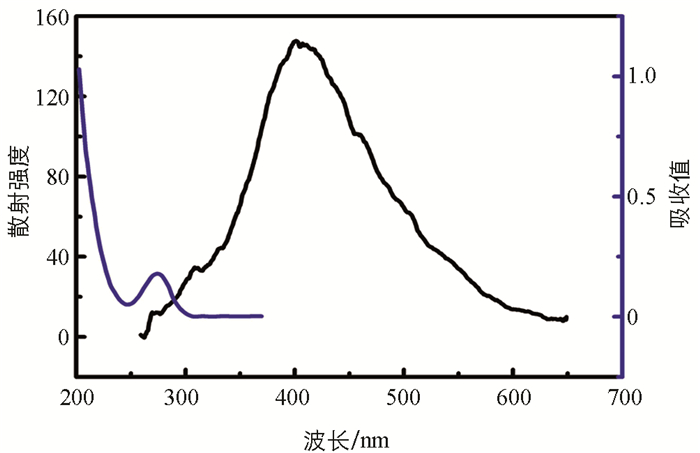
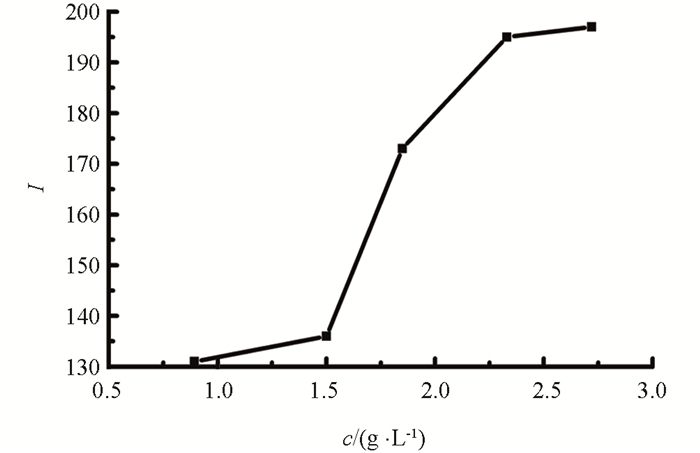
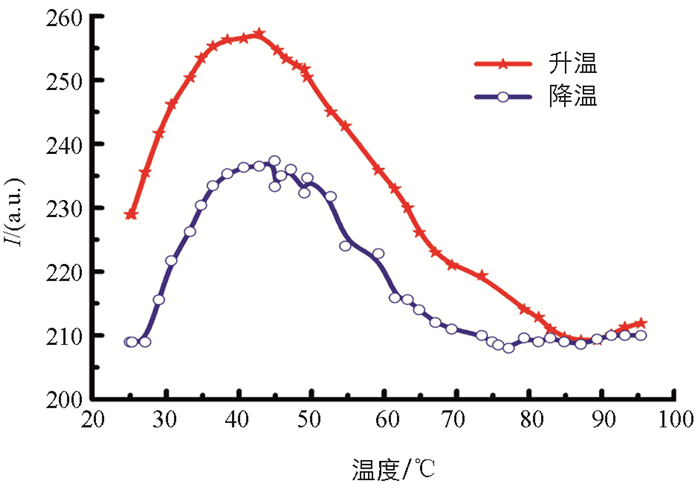
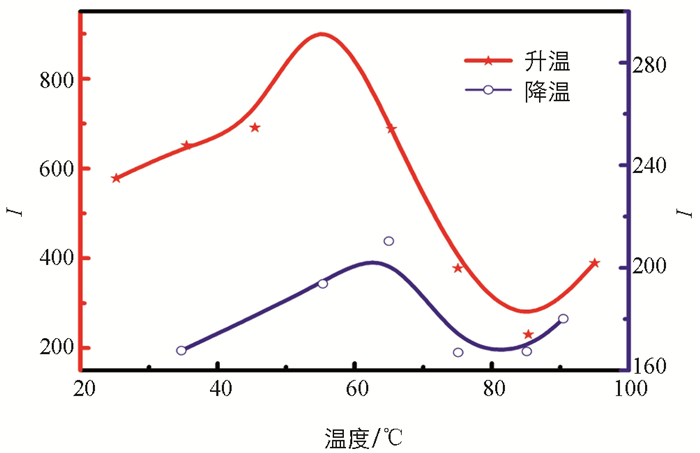

 DownLoad:
DownLoad: